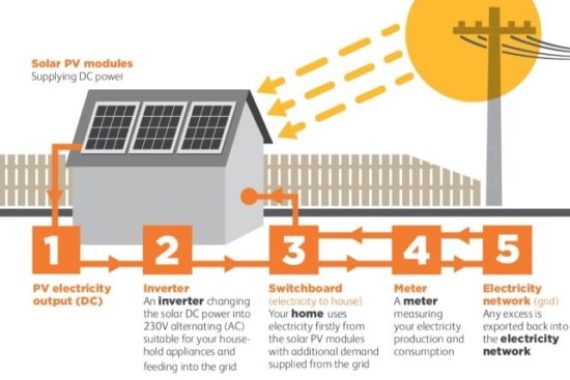RESIDENTIAL SOLAR
Types of Solar PV Systems
A solar PV system is made up of a mounting frame with PV modules and an inverter that converts the power from DC (direct current) to AC (alternating current), so it can be used in your home or exported back to the grid.
Grid-connected Solar PV Systems
This is the most common form of solar system installed in Australia. The inverter converts the electricity generated by the solar system – which is direct current (DC) – into AC electricity so that the power generated is compatible with the grid. Most houses with grid-connect solar systems use solar power frst before sourcing electricity from the grid. When the panels are not producing electricity at night, electricity is supplied from the electricity grid.

ANCHOR is our Smart Power Management System
Unlike the traditional monitoring system ANCHOR does not only monitor your solar production but it also Monitor how much power you are using in your home, it allows you to optimize the use of solar power to lower your energy bills and control appliances connected to smart plugs, right from the palm of your hand. This way you can see how much energy your solar panels are producing, how much you’re using and how much you’re sending back to the grid. If you notice you’re producing more than you’re using, make the most of it by switching on one of your connected appliances or, if you have batteries, save it to use later. You’ll never waste another kilowatt! ANCHOR works with every PV solar system, and goes the extra mile by alerting you if something’s up. You can relax knowing that your solar system is working at its best for you at all times.
You can track your savings every month and take the guesswork out of the return on your solar investment.
"Power, when you need it" Our ANCHOR smart system integrates solar with battery storage to supply the majority of your home’s energy. Battery storage provides backup power during utility outages.
"Intelligent Energy Management" You can monitor your energy consumption anytime, anywhere and you can monitor from your phone, tablet or computer 24/7.
"Get the details you’re after" Pinpoint days you want more info and dive in deep. You’ll get more than just data. Day summaries give you the insights you need to understand your energy use patterns. You can start living in a more energy-friendly way, which is good for you, your pocket and the planet.
"Smooth your transition to sustainable living" Getting solar or batteries is a big investment. Make sure you know exactly what you need before you make the decision. Measure up your energy use and make an informed decision about the battery or solar system size that will best fit your needs and lifestyle.
"Improve your energy efficiency" Keep an eye on your energy data to improve your energy efficiency. Easily identify energy efficiency improvements and track the results of efficiency upgrades (such as LED installation).
Grid-connect With Battery Back-up Solar PV Systems
Grid-connect PV systems with battery back-up (sometimes referred to as uninterrupted power supply or hybrid solar PV systems) are becoming increasingly popular. With solar customers in many states now receiving a low price for electricity sold back to the grid, battery back-up systems can be a viable alternative as they use the electricity stored during the day to run your house at night. They also have the advantage of being able to supply power during power outages.
Stand-alone Solar PV Systems
Stand-alone systems are not connected to the electricity grid and typically are installed in remote areas where there is limited connection to the grid, or areas of low electricity demand. Unlike their grid-connected counterparts, these systems must have batteries or backup generation to provide supply at night. In many cases they will also include a diesel or petrol generator to supplement energy supply.
Who Can Design And Install What?
Grid-connected solar PV systems:
Installers and designers need Clean Energy Council grid-connect accreditation.
Grid-connect with battery back-up solar PV systems:
Installers and designers need Clean Energy Council grid-connect accreditation with battery back-up endorsement, OR both grid-connect AND stand-alone accreditation.
Stand-alone solar PV systems:
Installers and designers need Clean Energy Council stand-alone accreditation
